
* In the 1970s, both the US and the USSR introduced a low-level strike aircraft with "variable geometry (VG)" or "swing wings". The US General Dynamics F-111 would prove, after a troubled development history, a capable machine; its Soviet counterpart, the "Sukhoi Su-24", would prove generally a match, and is still retained in service. This document provides a history and description of the Su-24.
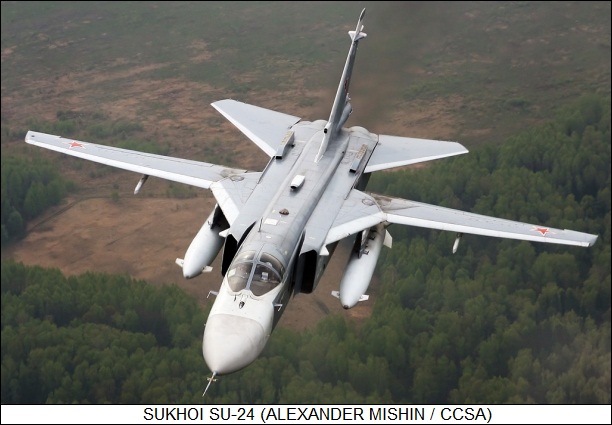
* In the mid-1960s, the Soviet Red Air Force (Voyenno Vozdushniye Sily / VVS) was confronted with the need to obtain a capable long-range strike aircraft for the service's Frontal Aviation (VVS-FA) component. The Yakovlev Yak-28 "Brewer" had proven a disappointment in the strike role, being lacking in range and limited in warload. Development was moving ahead in the US on the General Dynamics F-111 swing-wing / variable-geometry strike aircraft at the time, with the F-111 looking very much like the kind of machine that the VVS needed: a capable strike aircraft with good range and warload, capable of penetrating defended airspace at low altitude in order to evade radar and surface-to-air missiles (SAM).
A request for proposals was issued to the Mikoyan (MiG) and Sukhoi experimental design bureaus (Russian acronym OKB) for a low-level strike aircraft. The requirement was demanding, specifying a machine with a strong airframe to withstand the buffeting of low-level flight, as well as advanced engines with a good power to weight ratio and low specific fuel consumption. Advanced navigation and flight control systems would be required to support low-altitude penetration.
The MiG OKB developed what would become the "MiG-27 Flogger-D" single-engine VG strike fighter, while the Sukhoi OKB would produce the comparable "Su-17 Fitter". The MiG-27 and the Su-17 were not in a league with the US F-111, being smaller, with less range and warload, but Sukhoi also invested effort in development of a heavy strike aircraft much more comparable to the F-111. After tinkering with a number of preliminary designs, the Sukhoi OKB went forward on development of a series of flight prototypes for the heavy strike aircraft under the OKB "T6" designation.
The initial prototype, the "T6-1", was heavily influenced by the Sukhoi Su-15 "Flagon" interceptor, or more specifically by a "short take-off and landing (STOL)" demonstrator designated the "T-58VD" that had been converted from an Su-15. This machine had a stretched fuselage to accommodate three Kolesov "liftjets" -- small but powerful turbojets that were installed near-vertically to provide auxiliary thrust to get the machine off the ground, with forward propulsion provided by ordinary turbojets.
The Soviets were somewhat infatuated with the liftjet concept at the time, and it was not surprising that the Sukhoi OKB initially considered it as an appropriate configuration for the T6. As the T6-1 prototype emerged, it had a general configuration like that of the Su-15, with a cranked-delta wing, the "T" standing for "treoogol'noye (delta)"; conventional swept tail assembly, with all-moving tailplanes; a fuselage accommodating twin main engines; and dee-style intakes with variable inlet ramps. The main engines were Tumanskiy R-27F2-300 afterburning turbojets with a maximum afterburning thrust of 99.6 kN (10,160 kgp / 22,400 lbf) each -- complemented by four Kolesov RD-36-35 liftjets, installed in a bay behind the cockpit. The liftjets were installed at 15% forward of the vertical, with intakes and exhausts hidden behind doors except for take-offs and landings; they generated 23.1 kN (2,355 kgp / 5,195 lbf) thrust each.
Initial flight of the T6-1 was on 2 July 1967, with well-known OKB test pilot Vladimir Ilyushin at the controls. However, the VVS soon changed the specifications, demanding greater warload, and the liftjet scheme was no longer seen as practical. Besides, the low-level ride of the T6-1 with its big cranked-delta wing was extremely rough, "like riding a washboard" as one test pilot put it, being both hard on aircrew and airframe.
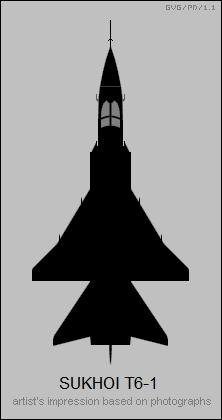
Working from data provided by the Central Aerodynamics & Hydrodynamics Institute (TsAGI in its Russian acronym), in late 1967 Sukhoi OKB engineers decided to focus on a VG concept instead, resulting in an aircraft concept much more similar to the US F-111. In fact, in 1967 the F-111 had put on an impressive performance at the Paris Air Show, helping convince the Soviets that VG was the way to go.
* Several different VG configurations were considered, but the final decision was to simply modify the T6-1 design by fitting it with a VG wing, resulting in the "T6-2I" prototype, where the "I" stood for "izmemyayemaya (variable)". That designation was a bit of a political dodge, since the new machine wasn't really a delta anymore, but funding was tight and OKB management didn't want the political authorities to think that the T6-2D was an entirely new design -- which it wasn't anyway.
When the T6-2I performed its initial flight on 17 January 1970, once again with Ilyushin at the controls, it was still a substantially different aircraft. Along with the VG wings, it was powered by new, powerful Lyulka AL-21F afterburning turbojet engines, not the R-27F2-300 engines of the T6-1. The AL-21F had actually been the intended engine for the T6-1 but wasn't available in 1967. The T6-1 was used to trial the AL-21F once it did become available, with the aircraft also modified with turned-down wingtips. The T6-1 would eventually end up in the air museum at Monino.
In addition, fixed ventral fins were added, the fuselage was modified, the tailplane shape was changed to mesh more closely with the VG wings when they were fully swept, and the undercarriage was strengthened to compensate for higher take-off weight.
The T6-2I seemed promising and was followed by four more prototypes -- T6-3I, T6-4I, T6-5I, and T6-6I. The T6-3I was lost in a crash in 1973, the crew being killed, but otherwise the flight test program went well. The test program lasted into 1976, but the VVS felt confident enough of the design to order it into production as the "Su-24" in 1971. Manufacture was performed at State Factory Number 153 in Novosibirsk, Siberia, with the first production aircraft rolled out in December 1971; all production machines would be built at this factory. The early production machines were actually used for evaluation and trials, with the first VVS unit formed up in 1973 and formal introduction to operational service in 1975. Once NATO got wind of the type, it was assigned the reporting name of "Fencer", though it was initially thought to be the "Sukhoi Su-19".
* The evolution of the Su-24 from the Su-15 through the liftjet T6-1 tends to undermine the perception in the West at the time that the Su-24 was a clone of the General Dynamics F-111. Some of the critics of the F-111, which had a notoriously difficult development history, were delighted with the idea that the Soviets had tried to copy it!
In reality, though the Su-24 did end up having a definite configurational resemblance to the F-111, it is hard to say that the Su-24 had any apparent debts to the American design, except for the VG wing. The resemblance was a case of "convergent evolution", with two aircraft designed to similar specifications and drawing from the same contemporary pool of design concepts unsurprisingly ending up looking a good deal like each other. The "copycat" accusation was not all that unreasonable on the face of it, however, since the general similarities of the two types were indeed striking, with the Su-24 having dimensions like those of the F-111, marginally lower maximum weight and warload, and marginally faster top speed. The major distinction between the two was that the Su-24 had only about 60% of the unrefueled range.
BACK_TO_TOP* The baseline Su-24 went through a series of substantial refinements in production. NATO tried to track production refinements through guesswork and defined three separate "variants" of the Su-24, with early production machines labeled as "Fencer-A" by NATO, later machines as "Fencer-B", and the final-configuration Su-24s as "Fencer-C". The definitive late production Su-24 Fencer-C is described here as a "baseline".
The Su-24 Fencer-C was built mostly of aircraft aluminum alloy, with the airframe organized in three main assemblies -- forward, center, and rear. It had a high-mounted VG wing, pivoting in fixed "wing gloves" close to the fuselage; a conventional swept tail assembly with all-moving tailplanes; twin fixed ventral fins; and tricycle landing gear. The pilot and navigation / weapons systems officer (NWSO) sat side-by-side in a pressurized and climate-conditioned cockpit. Controls were hydraulically actuated by a triple-redundant hydraulic system, and there were dual-redundant pneumatic systems. Electrical power for the aircraft's extensive avionics systems was provided by twin generators in the rear fuselage, with the generators presumably driven by the turbojet engines.
The aircraft was powered by twin Lyulka AL-21F-3 afterburning turbojets with 75.5 kN (7,800 kgp / 17,200 lbf) dry thrust and 110 kN (11,250 kgp / 24,800 lbf) afterburning thrust each. They were fed through fixed dee-type inlets -- early production had variable inlets, which refused to work properly despite the introduction of fixes. The fixed inlets were more effective and much lighter; they restricted low-level speed to Mach 1.4, but by the 1970s the infatuation with Mach 2 performance had worn off anyway, and there was no perceived need for the higher speed -- flying at Mach 2 at low level wasn't all that practical, in particular since the shockwave would leave a wake of indiscriminate destruction along the ground track. The inlets featured splitter plates next to the fuselage to prevent the ingestion of stagnant "boundary layer" air that hugged the fuselage, and also had ice protection and debris extraction. There was a small cooling inlet above the rear fuselage for each engine, and a heat exchanger on the back to cool off engine bleed air for use in cabin pressurization and so on.
The wing gloves had a leading-edge sweep of 69 degrees, while the wings could be set manually to 16 degrees for take-off and landing; 35 degrees for high-speed cruise; 45 degrees for combat maneuvering; and 69 degrees for supersonic dash. The wings had zero degrees incidence and an anhedral droop of 4.5 degrees, with each wing featuring a full-span leading-edge slat in four sections; a two-section spoiler / airbrake on top; and three-section rear flaps. There were no ailerons, with roll control handled by the tailplanes -- they could pivot in opposite directions to perform rolls and were called "stabilators". The tailfin had a noticeable "kink" on the upper leading edge, which was introduced after early production demonstrated the need for a tailfin with greater area. There was an intake in the lower leading edge of the tailfin to provide cooling airflow to the aircraft electrical power generation system.
All three landing-gear assemblies had twin wheels, with the nose gear retracting backward, while the main gear retracted forward into the fuselage, rotating 90 degrees to tuck in. The gear was hydraulically actuated, with a pneumatic backup system. The hydraulically actuated main gear doors also doubled as airbrakes -- they tucked back in once the main landing gear was deployed to reduce drag. The landing gear was very robust, and also very effective on rough airstrips; the nose gear had a mud guard to prevent it from spattering debris into the intakes. In principle, the wheels could be swapped out for skis, but it is unclear if that was ever done operationally.
* Built-in armament consisted of a Gryazev-Shipunov GSh-6-23 six-barreled 23-millimeter Gatling-type cannon in a fairing under the right side of a fuselage. There was a similar fairing on the left side of the fuselage, giving the appearance of a fit of two cannon, but the left fairing was for an ammunition store containing 500 rounds to feed the cannon; the ammunition fairing also featured a gun camera in the nose. The cannon had a cyclic rate of fire of 9,000 rounds per minute, and was boresighted to fire 2 degrees below the flight axis of the aircraft.
The Su-24 Fencer-C had eight stores attachments: one on each outer wing that pivoted along with the wing swing; one on each wing glove; and four under the fuselage. The fuselage pylons included two pylons side-by-side between the main gear assemblies, and two pylons on the centerline, one between the cannon fairings and one just behind it, forward of the main gear assemblies. Total external load was up to 8,000 kilograms (17,640 pounds), with stores including:
The wing glove pylons were "wet", and could each carry a single 3,000-liter (792 US gallon) PTB-3000 finned external tank. A single 2,000-liter (132 US gallon) external tank could also be carried on a centerline pylon; pictures suggest that while the wing-glove external tanks were a common store, the centerline tank was rarely fitted. All internal fuel storage was in the fuselage, the wing arrangement making wing tanks problematic, with three fuselage tanks providing a total capacity of 10,860 liters (2,865 US gallons). The internal tanks featured an inert gas system to reduce fire hazard.
* The pilot and NWSO sat on Zvezda K-36DM "zero-zero (zero altitude zero speed)" ejection seats; early Su-24 production had K-36D seats, which lacked the K-36DM's ability to allow either crewman to fire both seats. The pilot was on the left, the NWSO on the right. The control layout was analog, but the pilot's station had a head-up display (HUD); the cockpit color scheme was the striking turquoise generally used by the Soviets as an ergonomic measure. Both crew members had a stick to permit either to fly the aircraft. The two-piece windscreen was reinforced to tolerate bird strikes. From the side, the Su-24 appeared to have a normal clamshell canopy, hydraulically hinging open from the rear, but in fact it had a separate canopy half for each crewman. The canopy halves were blown off before ejection.
Avionics were sophisticated by the standards of the time. The core of the avionics suite was the PNS-24 Tigr navigation-attack (nav-attack) system, which integrated a number of avionics subsystems. Avionics subsystems included:
It is unclear exactly which of these subsystems were regarded as part of the PNS-24 suite. The nose of the Fencer-C featured a somewhat cluttered assembly with a bent "gooseneck" air data probe on top and antennas for the countermeasures system; the assembly under the nose for the Chaika targeting system also included antennas for the countermeasures system.
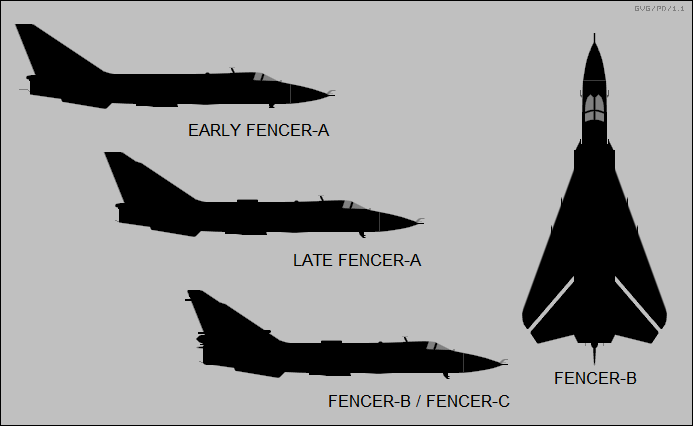
* The Su-24 evolved through a series of production blocks up to the Fencer-C specification. Contrasted with the Fencer-C, initial "Fencer-A" production had:
Changes were made in subsequent production blocks:
* In service, Su-24s were typically painted with white undersides and nose, medium gray everywhere else. Aircrews transitioning to the Su-24 from the Yak-28 were generally happy with the machine, the Su-24 being a much more satisfactory aircraft. The cockpit was comfortable and the control layout well-thought-out. The aircraft was straightforward to fly, though a number of flight restrictions were imposed early on until the bugs were worked out. Takeoffs and landings were comfortable, though the aircraft could stall on landings if one main gear assembly didn't extend, or if the flaps didn't deploy while the aircraft was at a high angle of attack. The pilot also had to be careful to remember that on landings or take-offs, extending or retracting the landing gear meant the main gear doors / airbrakes popped out for a moment, slowing the aircraft. Aircrews called the aircraft the "Chemodahn / Suitcase" for its boxy appearance.
On the negative side, although the Su-24's airframe was rugged and generally reliable, the machine was unusually sophisticated and complicated, and early on avionics system reliability was very poor. The number of maintenance hours required to turn around the Su-24 for a new mission was substantially greater than that for other VVS types. As noted above, Sukhoi OKB engineers kept trying to improve the machine, adding fixes through production.
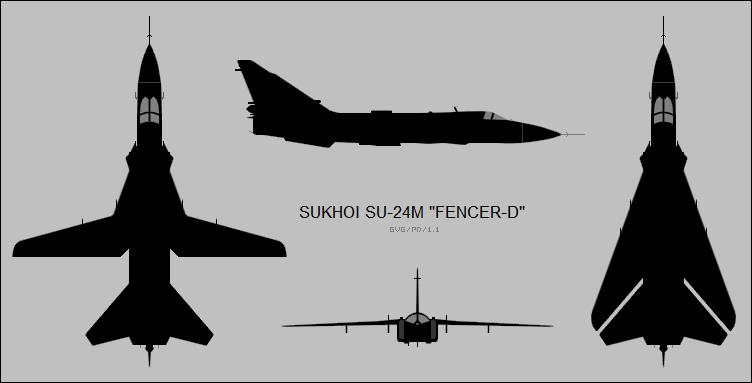
* In 1975, work began on a new Su-24 variant with substantial changes, with this version going into production in 1978 as the "Su-24M", which was assigned the NATO reporting name of "Fencer-D". The modifications included:
The inflight refueling capability of the Su-24M led the Americans to insist on including the type in strategic arms limitation talks. The relatively limited range of the original Su-24 series meant it could be reasonably judged to be a tactical aircraft, but with inflight refueling an Su-24M could, in principle, perform nuclear strikes on targets far outside East Bloc borders.
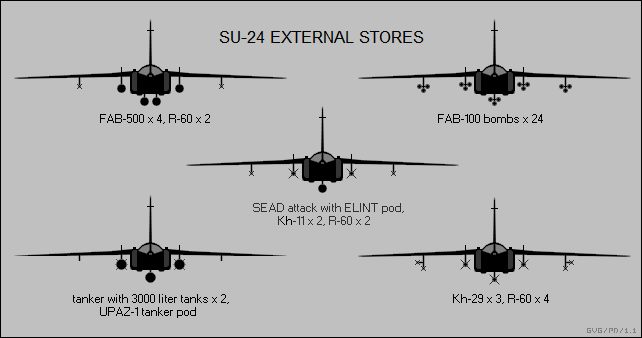
Total production of Su-24 attack variants -- Su-24 and Su-24M -- for Soviet service has been given as 635 aircraft.
___________________________________________________________________
SUKHOI SU-24M "FENCER-D":
___________________________________________________________________
wingspan (swept):
10.4 meters (34 feet)
wingspan (extended):
17.6 meters (57 feet 10 inches)
wing area (swept):
51 sq_meters (549 sq_feet)
wing area (extended):
55.2 sq_meters (594 sq_feet)
length:
22.6 meters (74 feet 2 inches)
height:
6.19 meters (20 feet 4 inches)
empty weight:
22,300 kilograms (49,160 pounds)
normal loaded weight:
36,000 kilograms (79,365 pounds)
MTO weight:
39,700 kilograms (87,520 pounds)
max speed at altitude:
2,120 KPH (1,315 MPH / 1,145 KT)
max speed at sea level:
1,400 KPH (870 MPH / 755 KT)
service ceiling:
17,000 meters (55,755 feet)
max range:
2,850 kilometers (1,770 MI / 1,540 NMI)
combat radius (no external tanks):
560 kilometers (350 MI / 305 NMI)
combat radius (with twin 3,000-liter tanks):
1,250 kilometers (775 MI / 675 NMI)
___________________________________________________________________
* Although the Su-24 series was not intended for export, late in the 1980s that rule was relaxed, with an "Su-24MK" export version of the Su-24M built for a number of Middle Eastern states. The SU-24MK was almost identical to the Su-24M except for slightly downgraded avionics, the only visible difference being that it was fitted with squared-off, not rounded, wing fences, containing upward-firing chaff-flare dispensers. It of course retained the "Fencer-D" designation. Sales were modest:
Iranian Su-24s retained the light underbelly colors but had a desert disruptive camouflage pattern topside, and it is likely other Middle Eastern states used the same or similar color scheme.
BACK_TO_TOP* In the mid-1970s, the only reconnaissance assets of the VVS were the hopelessly outdated Ilyushin Il-28R and the short-range Mikoyan MiG-21R. In 1975 the Sukhoi OKB was tasked to develop a state-of-the-art reconnaissance platform based on the Su-24, but work on the Su-24M took priority, with full development of the reconnaissance variant not beginning until 1978. Two Su-24s were modified as prototypes of the "Su-24MR" -- where "R" stood for "razvedchik / reconnaissance" -- with the initial flight of the first prototype in September 1980. When NATO became aware of the variant, it was assigned the reporting name of "Fencer-E".
The cannon was deleted and only two pylons, both on the centerline, were fitted under the fuselage; the wing glove pylons and wing pylons were retained. A larger heat exchanger module was fitted on the spine. Attack avionics were deleted, to be replaced by a BKR-1 Shtyk (Bayonet) reconnaissance suite, which included:
Data from sensors that provided an electronic output could be relayed in real-time to a ground station. The aircraft carried a time synchronization system to permit the data to be properly interpreted. Two R-60 / AA-8 Aphid AAMs could be carried on a dual stores rack on the left wing pylon for self-defense. External tanks were normally carried on the wing glove pylons. At least a hundred Su-24MRs were built.
* Work on an electronic warfare (EW) variant of the Su-24 was performed in parallel with development of the Su-24MR, the EW machine to perform both SIGINT and electronic countermeasures (ECM). The first "Su-24MP" performed its initial flight in December 1979. Once NATO became aware of the Su-24MP, it was assigned the reporting name of "Fencer-F".
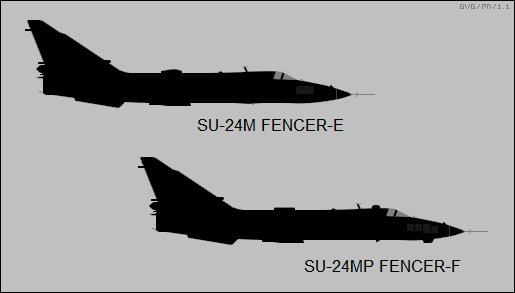
Only about 20 Su-24MPs were built, and the type remains somewhat mysterious. It had a prominent antenna fairing behind the cockpit; a similar fairing under the nose; four "hockey stick" antennas arranged underneath the aircraft; and a row of dielectric panels along each side of the nose. Various SIGINT and ECM pods could be carried on the centerline. The Su-24MP did retain the cannon and could carry AAMs on the outer wing panels for self-defense, but since it didn't have attack avionics, it couldn't carry most offensive stores. It may have been able to carry ARMs, but there is no evidence that it did so in service.
Both the Su-24MR and Su-24MP were painted much like attack Su-24s, even to the point of giving them full white "radomes", though they were a sham -- obviously in hopes of confusing Western intelligence as to which aircraft were which. Neither variant was exported.
BACK_TO_TOP* By the mid-1980s, the Su-24 was the primary heavy attack asset of the VVS-FA, with Su-24s often on quick-reaction alert status at Warsaw Pact bases for nuclear strikes against NATO targets. In the late 1980s, one air division of 87 aircraft was transferred to the AV-MF, the Soviet naval air arm, to be used in the Baltic region in the maritime strike role.
The Su-24 saw some action in the Afghan War, with aircraft flying from (what were then the Soviet states of) Uzbekistan and Kazakhstan. The Su-24s were used when heavy bombing and precision strikes against fixed targets were needed, the battlefield close-support mission being handled mostly by the Sukhoi Su-17 strike fighter. Typical warloads were two external tanks and either four 500-kilogram (1,100-pound) or twelve 250-kilogram (550-pound) general-purpose bombs. An initial series of Su-24 strikes in 1984 proved ineffectual, since the Afghan mujahedin guerrilla warriors were dug into rough terrain where it was hard to find targets, much less destroy them.
The Su-24 didn't come back until 1988, after Soviet forces had begun to disengage from the conflict. The major purpose of this second series of strikes was to keep the mujahedin from interfering with the Soviet withdrawal. Along with the 500- and 250-kilogram bomb loads, Su-24s also flew missions with four ODAB-500P fuel-air explosive (FAE) bombs, four RBK-500 cluster bombs, four 500-kilogram general-purpose bombs, or even four 1,500-kilogram (3,300-pound) general-purpose bombs. The FAE bombs, which are most effective in open terrain, proved generally useless, but the cluster bombs were savagely lethal. As far as the 1,500-kilogram bombs went, they were spectacular -- after one strike, a ground spotter called up to the strike element: "Holy crap! What are you guys dropping out there? It kicks the mountains right out from beneath my ass!"
No Su-24s were lost to ground fire, but at least one was lost in a landing accident. In another incident, a combat-weary crew taking off at night from Kazakhstan forgot to set the wings and flaps properly for take-off and ran out of runway -- managing to finally get airborne, but taking out part of the fence and a landing beacon before doing so. The aircraft completed its mission and returned to base safely, if a bit worse for wear. Ground crews observing the take-off suggested the aircrew were trying to make a high-speed ground run all the way into Afghanistan.
* In the post-Soviet era, the Su-24 remains an important asset of the Russian VVS, and of several of the post-Soviet states -- Ukraine was left with a number of Su-24s. The Su-24 is being gradually replaced by the Su-32 -- an improved, side-by-side two-seat derivative of the Su-27 "Flanker".
Some degree of upgrades are being applied to the VVS Su-24 fleet to keep it in service. In 2000, the Sukhoi organization publicized an upgrade package that featured conformal wing-root tanks, leading-edge wing-glove extensions, and a general avionics upgrade. The VVS did not buy off on the airframe changes, but did initiate modest upgrades from both Sukhoi and the Gefest&T organization, focused on a service-life extension program (SLEP) to keep the aircraft flightworthy, along with some avionics updates, most notably an updated navigation-attack system. The latest missiles and smart munitions were also qualified; Red Navy Su-24s have received the Gefest&T updates as well.
Deliveries of the Su-34 slipping out, the VVS moved towards a more comprehensive "Su-24M2" update, with a full glass cockpit, noted by large chaff-flare dispensers along the tailfin. Incidentally, it appears that Algeria's Su-24's have received or are receiving a similar update. It is unclear how much longer the Su-24 will remain in service, but the SLEP will keep the aircraft flightworthy for up to 30 years.
Russian Su-24s went back to combat in 2015, performing strikes in support of the Syrian government in the Syrian civil war. They were originally flown in theater with national markings painted over, but the national markings were soon restored. They generally performed strikes with four or six 250-kilogram (550-pound) or 500-kilogram (1,100-pound) HE bombs, and possibly with cluster munitions. Smart munitions were not much in evidence. 2015, incidentally, was the year when the VVS became the "RKS" or "Russian Aerospace Forces".
Russian Su-24s saw limited use after the Russian invasion of Ukraine in 2022, and were apparently a number were shot down by aggressive Ukrainian air defenses. Ukrainian Su-24s similarly proved ineffectual at first, and suffered painful losses as well. However, they came into their own in 2023, launching British Storm Shadow cruise missiles -- as well as nearly-identical French SCALP cruise missiles -- that allowed strikes at stand-off ranges, beyond the reach of Russian air defenses. They may have also been adapted to other Western munitions. Despite losses, the Ukrainian Su-24 fleet appears to have grown, it appears by refurbishing old mothballed airframes, and possibly obtaining retired airframes from other users.
BACK_TO_TOP* The following list summarizes Su-24 variants, with NATO reporting names:
* As usual for Soviet aircraft, older Western sources on the Su-24 are sketchy and full of small bogus details, such as presenting the cooling inlet on the base of the tailfin as an ECM system antenna and drawing up unrealistic stores loadouts, such as four external tanks.
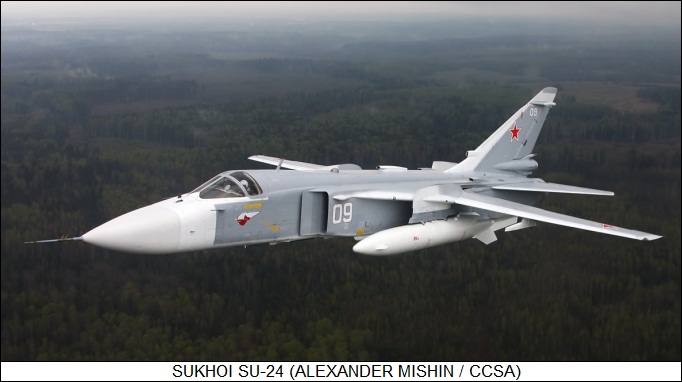
* Sources include:
* Revision history:
v1.0.0 / 01 may 07 v1.0.1 / 01 apr 09 / Review & polish. v1.0.2 / 01 mar 11 / Review & polish. v1.0.3 / 01 feb 13 / Review & polish. v1.0.4 / 01 jan 14 / Review & polish. v1.0.5 / 01 dec 15 / Review & polish. v1.0.6 / 01 oct 17 / Review & polish. v1.0.7 / 01 oct 19 / Review, update, & polish. v1.0.8 / 01 aug 21 / Review & polish. v1.0.9 / 01 jul 23 / Review & polish. v1.1.0 / 01 jul 25 / Review & polish.BACK_TO_TOP
